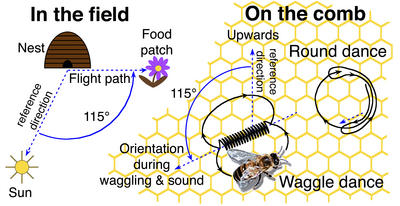 We took this brief (but exciting for us!) video of the bees performing a "waggle dance" in one of our colonies a few days ago. Foragers use the waggle dance to communicate to their sisters where they found a good source of nectar or pollen when the source is far from the colony (over 150 meters). She marches in a figure 8 pattern, wagging her tail as she walks down the center. She angles the center "waggle" in relation to the sun and the colony to communicate the direction of the source. The duration of each waggle she makes communicates how far away the source is.
We took this brief (but exciting for us!) video of the bees performing a "waggle dance" in one of our colonies a few days ago. Foragers use the waggle dance to communicate to their sisters where they found a good source of nectar or pollen when the source is far from the colony (over 150 meters). She marches in a figure 8 pattern, wagging her tail as she walks down the center. She angles the center "waggle" in relation to the sun and the colony to communicate the direction of the source. The duration of each waggle she makes communicates how far away the source is. If the source isn't far away, she'll perform a round dance--see diagram below.
 |
| Source: P. Kirk Visscher, University of California, Riverside. |
That is really interesting - the wiggle when she walks - are you old enough to remember that little ditty? - but does it work, are her friends taking notes? I didn't see anyone in the audience immediately head out to find her source? Do they? And do all bees do this "waggle" or only certain breeds?
ReplyDeleteHi Helen-I do remember the "wiggle when she walks" song! And these are great questions! To the best of my knowledge, honeybees are the only bees that do the waggle dance. Most other bees are solitary bees (like the mason bee and the bumble bee), so they don't have a colony to share information with. As for the waggle dancer's audience--many of the bees on the frame are too young yet to forage. Those worker bees live only 6 weeks in the summer, and "advance" through a series of jobs as they age (cleaning the colony, tending brood, undertaking, ripening honey, defending the entrance) before becoming foragers. Only the oldest honeybees forage for pollen and nectar. And they're the ones who watch their sisters' waggle dances most intently. Hope this helps. Thanks for leaving a comment! --Jennie
ReplyDelete